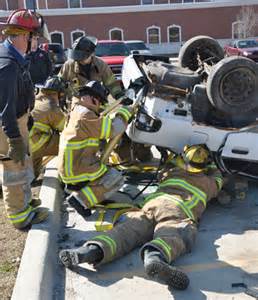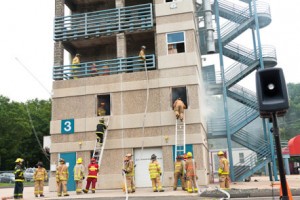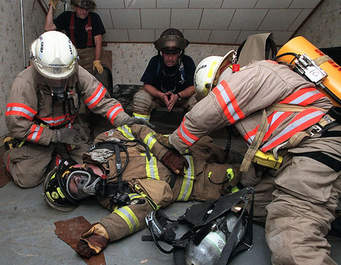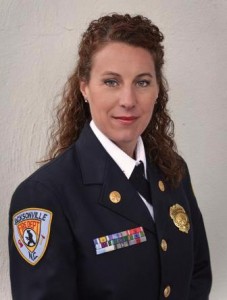Note from Chief Avsec: It gives me great pleasure to introduce Chief Susanna Schmitt Williams as my latest Guest Blogger in this space. Chief Williams currently serves as the Division Chief of Training for the Jacksonville (NC) Fire Department.
“Training teaches what Operations Does and Operations does what Training Teaches”
Merriam-Webster dictionary online defines training as “a process by which someone is taught the skills that are needed for an art, profession,  or job”. (Encyclopedia Britannica Company, 2014) Training in emergency services is just that…
or job”. (Encyclopedia Britannica Company, 2014) Training in emergency services is just that…
…and then some.
At its basic level, training in emergency services encompasses several things: learning new skills when one is new to the profession whether as volunteer or career, when one adds additional skillsets, for example when promoting to driver and honing/ fine tuning previously learned skills with your crew (company drills). Haz Ed offers fire protection and gas detection courses. The “and then some” is the Training Division’s influence on many aspects of an organization.
I believe it is safe to say there are not many emergency services personnel who would deny that training is paramount to successful operations on incidents. However, there are some whose actions would show otherwise.
Think of training participation and design as a pendulum. Swing to one side and we see those that participate in training, or at a department level, design training, solely to meet training mandates such as for ISO or OSHA. Swing to the other side of the pendulum and we see high dedication in personnel and department design of training that meets the needs based on call types, taking into account variables such as high risk/low frequency to high frequency/low risk types. And, of course, many departments fall at varying places along the swing of the pendulum.
There is sometimes a divide when it comes to training and its influence within an organization. DiNolfo, et al. addresses this very issue, noting how fire service instructors are often placed to the side in a “Training Division” on an organizational chart creating a sense of isolation. “Firefighters and even some fire officers are often seen as resisting or even obstructing the training process, because all too often those within the operations staff do not view training as having a high priority.” (DiNolfo, et al., 2009)
What many don’t realize is a training division’s ripple effects have far reaching influence on the organization in many ways. A few areas immediately coming to mind that stand to be impacted are operations and entry level training.
Operations
 Training not only reinforces foundational knowledge learned early on in one’s career (volunteer or paid) but also expands upon that introductory knowledge. For instance, with the latest research being conducted on fire behavior we have seen new techniques developed (or revisited) for initial fire attack. With change, however, comes turmoil and we’ve seen and heard resistive voices in the fire service concerning this research.
Training not only reinforces foundational knowledge learned early on in one’s career (volunteer or paid) but also expands upon that introductory knowledge. For instance, with the latest research being conducted on fire behavior we have seen new techniques developed (or revisited) for initial fire attack. With change, however, comes turmoil and we’ve seen and heard resistive voices in the fire service concerning this research.
Training can help change operational tactics, but only if the training is delivered at a pace the organization can handle. The approach I took with my organization was a slow introduction after seeing the national resistance and hearing some “scuttlebutt” in my organization. I have over the last three months introduced articles and videos as part of our monthly training objectives. This has preceded any actual drills. Had I jumped immediately into drills, this would have stalled or even prevented our adding these new procedures to our operational tactic toolbox.
This an example of where a training division being aware of the pace with which an organization is ready to accept changes can influence the acceptance of or drive changes in operational tactics. In the next several months my own organization will start on practical drills and develop operational polices to add these new initial fire attack tactics to our toolbox.
Entry Level Training
Entry level training (new hire/ new volunteer, call it what you will) is another area where a training division can have remarkable influence.  With good design and implementation, entry level training can build commitment to an organization in its newest members. It can set the foundation for good customer service and the conduct of new personnel (member).
With good design and implementation, entry level training can build commitment to an organization in its newest members. It can set the foundation for good customer service and the conduct of new personnel (member).
In evaluating our new hire training when I started at my current organization as Training Chief, it was designed in a way that allowed for building commitment. New personnel have the opportunity to train with multiple shifts, stations, officers, and firefighters throughout their training program. This emphasizes the organization’s commitment for mentoring, guiding, instructing, and leading by all incumbent members for its newest members.
Our volunteer program functions in much the same way, but it wasn’t always like that. When I first assumed the role of Training Chief, my evaluation of the volunteer training program revealed that the Training Chief was tasked with always delivering training to volunteers. That was “how it was always done”, but it didn’t allow for volunteers the opportunity to train with multiple shifts, stations, officers, etc., like their career cohorts.
Today, our volunteer training program has the volunteers rotate stations each month for training and training is led by the Company Officer at that station. These are the personnel our volunteers will need to work with on an incident, not me, the Training Chief. The current training format allows the volunteers to build the needed relationships with our officers and firefighters. It also allows for them and our paid personnel to see where everyone fits in on the team.
This commitment to all being involved in training reinforces our city’s “Customer Service is at our Core” motto. Providing great internal customer service leads to great external customer service. Providing that internal customer service with training is one piece of the puzzle towards our personnel exhibiting great external customer service.
Summary
While functioning in a training division we may sometimes feel as if we are on a deserted island not sure if our efforts are having an impact. I challenge you to sit back and observe the ripple effects. You may be surprised at how far they extend out. I touched upon a few areas where I believe there is training division influence that are at the top of my list: operations and entry level training. I encourage you to keep the conversation going and share your ideas.
The Author
Susanna Schmitt Williams is Division Chief of Training for a Fire & Emergency Services Organization in North Carolina. She has 16 years  experience in the fire service having served as Firefighter, Master Firefighter, Driver Operator/Firefighter, Administrative Captain, Volunteer Program Coordinator, and Division Chief.
experience in the fire service having served as Firefighter, Master Firefighter, Driver Operator/Firefighter, Administrative Captain, Volunteer Program Coordinator, and Division Chief.
Chief Williams holds many fire service certifications, has earned two Bachelor degrees and a Masters Degree in Public Administration (concentration in Fire Service Administration). She is currently enrolled in EFO and FSEDI; and is working on her CTO credentialing. Chief Williams is also an instructor for the annual FireHouse Software Education Training Seminar and coordinates a regional seminar held annually in Wilmington, NC.
Works Cited
DiNolfo, S. H., Hirst, B., Klingensmith, B., Krizik, B., Larson, K., Peterson, D., et al. (2009). Fire Service Instructor Principles and Practices. Burlington: MA.
Encyclopedia Britannica Company. (2014). Merriam-Webster. Retrieved September 3, 2014, from Merriam-Webster: http://www.merriam-webster.com/dictionary/training
 Fire & EMS Leader Pro The job of old firefighters is to teach young firefighters how to become old firefighters!
Fire & EMS Leader Pro The job of old firefighters is to teach young firefighters how to become old firefighters!